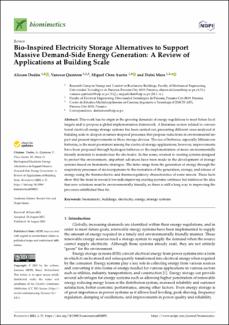Mostrar el registro sencillo del ítem
Bio-Inspired Electricity Storage Alternatives to Support Massive Demand-Side Energy Generation: A Review of Applications at Building Scale
| dc.contributor.author | Dodón, Alisson | |
| dc.contributor.author | Quintero, Vanessa | |
| dc.contributor.author | Chen Austin, Miguel | |
| dc.contributor.author | Mora, Dafni | |
| dc.date.accessioned | 2022-01-12T13:02:57Z | |
| dc.date.available | 2022-01-12T13:02:57Z | |
| dc.date.issued | 2021-07-26 | |
| dc.identifier.uri | https://doi.org/10.3390/ biomimetics6030051 | |
| dc.identifier.uri | https://ridda2.utp.ac.pa/handle/123456789/13481 | |
| dc.description | This work has its origin in the growing demands of energy regulations to meet future local targets and to propose a global implementation framework. A literature review related to conventional electrical energy storage systems has been carried out, presenting different cases analyzed at building scale to deepen in nature-inspired processes that propose reductions in environmental impact and present improvements in these storage devices. The use of batteries, especially lithium-ion batteries, is the most prominent among the electrical storage applications; however, improvements have been proposed through hydrogen batteries or the implementation of more environmentally friendly materials to manufacture the electrodes. In this sense, oriented to creating systems designed to protect the environment, important advances have been made in the development of storage systems based on biomimetic strategies. The latter range from the generation of energy through the respiratory processes of microorganisms to the recreation of the generation, storage, and release of energy using the thermoelectric and thermoregulatory characteristics of some insects. These facts show that the trend in research towards improving existing systems continues but reinforces the idea that new solutions must be environmentally friendly, so there is still a long way to improving the processes established thus far. | en_US |
| dc.description.abstract | This work has its origin in the growing demands of energy regulations to meet future local targets and to propose a global implementation framework. A literature review related to conventional electrical energy storage systems has been carried out, presenting different cases analyzed at building scale to deepen in nature-inspired processes that propose reductions in environmental impact and present improvements in these storage devices. The use of batteries, especially lithium-ion batteries, is the most prominent among the electrical storage applications; however, improvements have been proposed through hydrogen batteries or the implementation of more environmentally friendly materials to manufacture the electrodes. In this sense, oriented to creating systems designed to protect the environment, important advances have been made in the development of storage systems based on biomimetic strategies. The latter range from the generation of energy through the respiratory processes of microorganisms to the recreation of the generation, storage, and release of energy using the thermoelectric and thermoregulatory characteristics of some insects. These facts show that the trend in research towards improving existing systems continues but reinforces the idea that new solutions must be environmentally friendly, so there is still a long way to improving the processes established thus far. | en_US |
| dc.format | application/pdf | en_US |
| dc.language.iso | en_US | en_US |
| dc.publisher | MDPI | en_US |
| dc.rights | info:eu-repo/semantics/openAccess | en_US |
| dc.rights | https://creativecommons.org/licenses/by-nc-sa/4.0 | en_US |
| dc.subject | biomimicry | en_US |
| dc.subject | buildings | en_US |
| dc.subject | electricity | en_US |
| dc.subject | energy | en_US |
| dc.subject | storage systems | en_US |
| dc.title | Bio-Inspired Electricity Storage Alternatives to Support Massive Demand-Side Energy Generation: A Review of Applications at Building Scale | en_US |
| dc.type | info:eu-repo/semantics/article | en_US |
| dc.type | info:eu-repo/semantics/publishedVersion | en_US |
